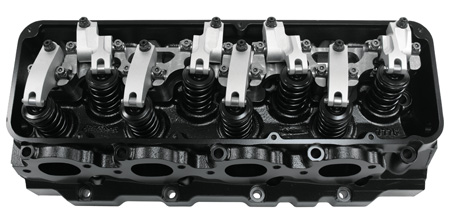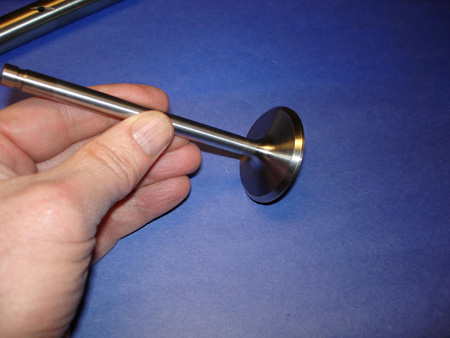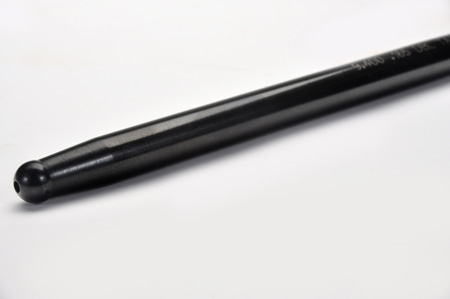Street performance requires everyday driveability and reliability. A good street performance engine should have a broad torque curve, plenty of low end power and a reasonable amount of intake vacuum at idle, especially if the engine is backed with an automatic transmission. A street engine also has to be capable of lasting tens of thousands of miles, not just a single race or a season of weekend racing.
A street performance engine also has to be affordable. Most street performance customers have a limited budget and lack the deep pockets of a well-sponsored professional race team. The recent economic downturn has crimped many people’s budgets even more, so everybody is trying to get the maximum value for every dollar they spend. Conse-quently, cost may outweigh almost everything else in the decision making process of choosing parts for a particular engine.
The valvetrain in particular deserves special attention when building a street performance eng-ine. NASCAR and Pro Stock drag racers have a lot of success using rocker arm ratios of up to 2.0:1 or higher, super-stiff 1,000-lb. valve springs and ultra-light titanium valves. Such parts are a must for making big of horsepower at high rpm, but these kinds of parts are usually either too extreme or too expensive for most street applications.
According to the valvetrain component suppliers we interviewed for this article, most street performance customers are running fairly mild valvetrains with stock or only slightly higher than stock rocker arm lift ratios. Aluminum needle bearing roller tip rocker arms are a common upgrade for the street. They are much better than stock stamped steel rocker arms, and are usually lighter and more affordable than the stronger steel roller rockers that have become so popular in professional racing.
“Most street performance engine builders today want a roller cam and roller rockers, with somewhat stronger springs and stock or slightly higher rocker arm lift ratio,” said Scott Scovrowski of Howards Cams. On SB Chevy engines, a rocker ratio of 1.6 on the intake valves and 1.5 on the exhaust valves seems to be the most popular ratios.
Chris Mays of Comp Cams says his company offers a line of Pro Magnum chrome moly steel rockers that offer advantages over aluminum rockers for the street. “Steel is more durable long term than aluminum, and the design of these rockers provides better clearance under the valve covers than most aluminum rockers.” Mays said the most popular ratios are 1.6 for SB Chevys, 1.7 for SB Fords and 1.8 for BB Chevys.
Scorpion Racing Products has a broad line of performance rocker arms, including narrow body and self-aligning versions that are well suited for street applications. The self-aligning rockers are quiet and do not require a guide plate, but the narrow body rockers do need a guide plate. Scorpion also has direct replacement bolt-on aluminum roller rockers for the LS1 Chevy, and a new lightweight Platinum Series of aluminum rockers for Chevy and Ford that are 20 grams lighter than their other rockers.
Schean Barrett of PRW says they sell a variety of rocker systems for street performance applications, including cast 4043 steel roller-tip rockers that sell for around $100 per set. For more demanding street applications, PRW offers their Blu-Max 6061 T-6 extruded aluminum full-roller rocker arms for around $200 a set that can handle up to 750 lbs. of open spring pressure. The rockers can be used with or without stud girdles to improve valvetrain rigidity. If a stud girdle is used, taller valve covers are required for clearance.
PRW also has stud-mount rocker arm systems available in 6061 T-6 aluminum or stainless steel for Chevy LS engines. The rockers come with 4130 chromoly pushrods and mounting hardware. They also have roller rockers for the new Chrysler Hemi that are a bolt-on replacement for the stock rockers.
Phil Elliott of T&D Machine says most of the rocker arms they make are custom pieces for race teams. He doesn’t really recommend his performance rockers for the street, but acknowledges that many of them end up on street engines anyway. T&D makes both steel and aluminum rockers. Steel has better fatigue strength and stiffness than aluminum, and can absorb more abuse than aluminum over time. What’s more, T&D’s steel rockers are actually lighter than their aluminum rockers.
But Elliott says rockers that are engineered for the race track may not work so well on the street because they have a limited life cycle. Though most of what T&D makes is for professional racers, they also have rockers for many of the new aftermarket cylinder heads. “We now have rocker sets for all of the new Edelbrock heads, including their new 409 Chevy heads,” says Elliott.
Bob McDonald of Jesel says many engine builders are using their Sportsman or Pro Series rockers for street applications. “We have both aluminum and steel rockers, though aluminum is more affordable for the typical street customer.” McDonald also says belt drives have become more popular for street engines because they allow quick and easy camshaft timing adjustments. Last year, Jesel introduced a new solid one piece upper pulley belt drive kit that is very affordable. He says a belt drive is quieter and stronger than a chain drive, won’t stretch as it ages like a chain will and reduces oil windage inside the timing cover.
Randy Becker Jr. of Harland Sharp says some of the more popular applications for late model rocker arm upgrades are the LS-series of GM engines, the 5.2L & 5.9L Dodge Magnum engines, and the 4.0L Jeep engine. “Most of our LS engine customers are choosing rockers with a stock ratio. Our replacement for that engine is a simple-bolt on pedestal style rocker similar to the OEM design, but with a full roller rocker and extra oiling hole for the roller tip to improve durability on the street. We are also polishing the rocker tips and trunnions to reduce friction and wear.
Becker said Harland Sharp is currently manufacturing aluminum rockers only, but is developing steel rockers for SB and BB Chevy V8s that should be available later this year. Though intended primarily for racing, the steel rockers would also be suitable for street use, too. Harland Sharp also has shaft-mounted rockers for many popular aftermarket heads, as well as Chevy LS engines and the new Chrysler Hemi applications.
Shaft mounted rocker systems provide a significant improvement in valvetrain rigidity and strength over stud-mounted rockers. But due to their high cost, shaft-mounted rocker systems are used primarily for racing rather than the street – unless you are talking some early 1950s vintage V8s or six cylinder engines that were originally equipped with shaft mounted rockers.
“Rocker shafts for older engines can be hard to get these days,” says Vern Schumann of Schumann Sales & Service. “We now make replacement rocker shafts for many older engines include 1950s and 1960s vintage Ford Y-block (272/292/312) and FE engines, Chevy six cylinder, Oldsmobile and Buick engines.”
Schumann says he has upgraded valvetrain components for many of these older engines, including 21-4N stainless steel valves, tubular heat treated steel and chrome moly pushrods (available in custom lengths), mirror micro-finished parabolic flat tappet lifters, and high silicon and chrome vanadium wire valve springs.
Camshaft Issues
The type of valvetrain components you choose will also depend on the type of camshaft that’s used. Flat tappet cams have long been the norm for most small block and big block Chevy and Ford V8s.
Flat tappet cams are simple and affordable, and offer a choice of solid or hydraulic lifters. Solid lifters are capable of higher rpms and can be adjusted to fine tune the valvetrain, while hydraulic lifters eliminate valvetrain noise as well as the need for periodic valve lash adjustments. Hydraulic lifters are usually the best choice for most street engines, but some customers may insist on the clatter and adjustability of high revving solid lifters.
Roller lifters (solid or hydraulic) offer a significant reduction in friction compared to a flat tapped cam, and can also handle steeper cam lobes for faster valve opening and closing rates. Fast lift, short duration cams are ideal for the street because they make good low and mid-range power for off-the-line performance and everyday driveability. But their added complexity makes them more expensive than flat tappet cams. Even so, several camshaft manufacturers reported that more street engine builders are opting for hydraulic roller cams these days, primarily to avoid lubrication issues with today’s motor oils.
For many years, ZDDP (Zinc Dialkyl Dithio Phosphate) was added to motor oil as an extreme-pressure additive. The highest load area inside an engine is typically the point where the valve lifter rides on the cam lobe. The OEMs have not used flat tappet cams in engines for many years. Roller cams and overhead cams with followers produce much less friction and have much lower loads, so high levels of ZDDP are no longer needed in today’s oils. Besides, over time ZDDP can reduce the life of the catalytic converter by contaminating the catalyst.
In 2005, the amount of ZDDP allowed in “SM” motor oil was cut roughly in half. The American Petroleum Institute (API) says the latest motor oils are still backwards compatible with older engines that have flat tappet camshafts. Even so, many engine builders have learned the hard way that the amount of ZDDP in today’s oils is probably not adequate for a flat tappet valvetrain that is running higher than stock valve spring pressures. So the only way to avoid camshaft failures due to lubrication issues is to use a ZDDP or other high pressure motor oil additive, or to switch to a roller cam.
The problem with ZDDP additives is that you are not supposed to use them in late model engines if the vehicle has a catalytic converter. Don Weber of Engine Pro says his company sells an oil additive called “Extreme Engine Protector” for use with flat tappet cams. The additive contains no lead or zinc, and is safe for use in vehicles with catalytic converters. The additive is a calcium petroleum sulfonate complex with an acid neutralizer. It is a non-chlorinated, non-sulfurized, non-leaded extreme pressure agent that reduces friction, protects the cam lobes against wear, and actually improves fuel economy.
Weber says another way to reduce the risk of lubrication-related flat tappet cam failures is to use lifters that have a small oiling hole that routes more oil to the cam lobe.
“Though more engine builders are going to hydraulic roller cams for street motors, we still sell 10 to 12 times as many flat tappet cams as roller cams,” says Weber.
Many other engine parts suppliers offer similar types of additives as well. Check with your distributor to find out what’s available – and is most appropriate – for your situation.
Valves, Springs & Pushrods
For street performance applications, our 53 Series 21-2N stainless steel valves have been very popular,” says Ian Levitt of Qualcast. “These are a swirl polished valve with a hardened tip. Price seems to be the main deciding factor for many street engines lately due to the economy, though things have started to improve since the first of the year. Engine builders want a swirl polished stainless steel valve, but they also want a low price. Our 53 Series valve fills that bill, and can be used on the street or for racing, though we do recommend our 12 Series 21-4N valves for serious racing.”
Brian Bender of SB International says many street performance engines use stock valvetrain components such as valves, seats and guides, but typically upgrade other parts such as springs, rockers and pushrods. “Though price is always a concern for street customers, durability is also essential.”
One way to improve valvetrain durability, according to Rick Simko of Elgin Industries, is to improve the metallurgy of the parts themselves. Elgin recently introduced a line of “Pro-Stock Black Ice” cryogenically treated valvetrain components for both street and racing applications.
Elgin’s in-house cold treatment process chills parts down to several hundred degrees below zero before allowing the parts to slowly return to room temperature. The freezing process develops the maximum attainable hardness in the parts for improved fatigue and wear resistance, while also reducing internal stresses for better dimensional stability. The Black Ice line includes valves, valve springs, spring retainers, rockers, pushrods, camshafts and timing gear sets. “We’ve seen 25 to 30% better wear life with our cryogenically treated parts,” said Simko, which is a plus on the street or the race track.
Scott Scovrowski of Howards Cams says one of the most important criteria for any street engine is valve springs that last. Street engines run a lot more miles than a race engine. Valve lifts and rpms are lower, but the valves still take a beating as the miles add up. So the springs have to be capable of maintaining their pressure over hundreds of thousands of cycles.
“We use high quality materials in our springs, and electro polish the springs to improve their durability even more,” says Scovrowski.
One tip for reducing the risk of a valvetrain problem when assembling a new engine is to soak the valve springs, lifters and rockers in oil overnight. It’s also important to use an assembly lube with a high pressure additive, and to prime the engine’s oil system before the first start.
Pushrods are another important component that should not be overlooked when building a street performance engine. If the springs are stiffer than stock, stiffer pushrods are usually required. Strength is more important than weight, since the pushrod side of the valvetrain moves less than the valve side. Pushrods with thicker walls and/or stronger metals are necessary to handle higher valve spring pressures.
Don Weber of Engine Pro says engine builders must use hardened pushrods in any engine that has a guide plate. “We sell a .083? wall chrome moly pushrod, as well as a stronger 1010 steel .094? wall pushrod that is less expensive than a chrome moly pushrod, but is much better than a stock pushrod.”
Pushrod length is also important and must be matched to the engine if the base circle of the camshaft has been changed, and/or the cylinder head or deck height has been machined. An adjustable pushrod should be used to determine the correct length. Also note that pushrod lengths from some manufacturers can vary quite a bit, so look for pushrods that are consistent to within .005?of each other.
For a complete list of valvetrain component suppliers and manufacturers, visit our Online Buyers Guide. 















